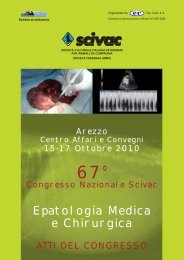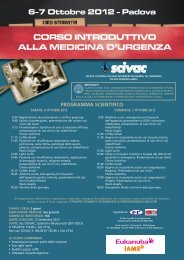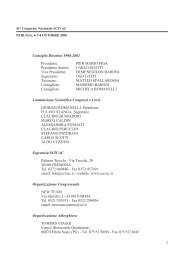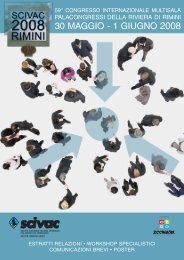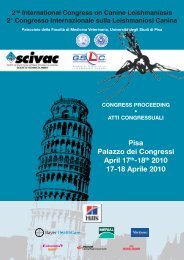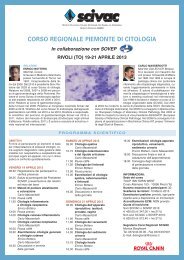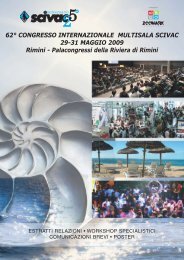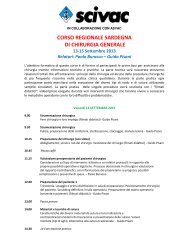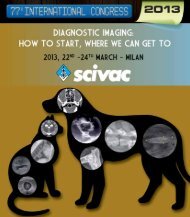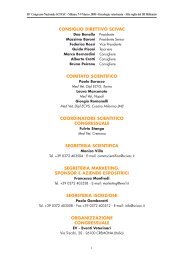68° Congresso Nazionale SCIVAC: Le domande più frequenti in ...
68° Congresso Nazionale SCIVAC: Le domande più frequenti in ...
68° Congresso Nazionale SCIVAC: Le domande più frequenti in ...
You also want an ePaper? Increase the reach of your titles
YUMPU automatically turns print PDFs into web optimized ePapers that Google loves.
<strong>68°</strong> CONGRESSO NAZIONALE <strong>SCIVAC</strong> 11-13 Marzo 2011 - Milano<br />
LE DOMANDE PIÙ FREQUENTI IN RIPRODUZIONE CANINA E FELINA<br />
Tutto quello che i vostri clienti osano spesso chiedere e a cui voi non sapete rispondere<br />
14 th EVSSAR Congress - Advances <strong>in</strong> Fel<strong>in</strong>e Reproduction - March 11 th 2011<br />
1. MANAGEMENT OF THE HEALTH PUPPY<br />
At birth, puppies have almost no subcutaneous fat, few brown fat, a high<br />
surface/volume ratio. Shiver<strong>in</strong>g and vasoconstrictive mechanisms are not efficient<br />
until 6-8 weeks of age. Micturition and defecation reflexs are not effective.<br />
When possible, it is best to let the bitch mothered her puppies under owner<br />
supervision (when no maternal behaviour past). She will protect her litters <strong>in</strong><br />
part from coldness, feed them as many times as necessary, clean and stimulate<br />
their ur<strong>in</strong>ation and defecation. The mother is an essential source of heal<strong>in</strong>g.<br />
The mother has a primary role <strong>in</strong> the future <strong>in</strong>teraction of the puppy with<br />
other dogs and his environment (<strong>in</strong>clud<strong>in</strong>g humans).<br />
If, the puppy is orphan, the bitch is not milk<strong>in</strong>g or not enough, puppy<br />
bodyweight is not <strong>in</strong>creas<strong>in</strong>g more than 2 g/kg of adult bodyweight, owner<br />
and vet have to give a nutritional support.<br />
- Diet<br />
Colostrum is the ma<strong>in</strong> source of immunoglobul<strong>in</strong>s (> 98%) for the<br />
neonates. 8 hours after birth, the <strong>in</strong>test<strong>in</strong>al tract start to limit the absorption<br />
with only one third of colostrum antibodies absorbed and none after 24 to 36<br />
hours. Colostrum and milk are also the only source of energy, prote<strong>in</strong>s, m<strong>in</strong>erals<br />
and vitam<strong>in</strong>s before nurs<strong>in</strong>g (3 to 6 weeks of age).<br />
Colostrum can be collected from the bitch <strong>in</strong> the first day and booze to<br />
puppies. Colostrum may be stored over one year <strong>in</strong> the freezer from another<br />
bitch if the mother has no milk. Some synthetic colostrum are commercialized<br />
(Immustrum ® ) but are bov<strong>in</strong>e immunoglobul<strong>in</strong>s and not specific from the<br />
kennels microbism. In the absence of colostrum source, other solutions may<br />
help and will be detailed (serotherapy, ...).<br />
How to feed? 5% of BW 8 (1 st week) to 4 (3 rd week) times a day by suckl<strong>in</strong>g<br />
(<strong>in</strong> 15 m<strong>in</strong>utes) or oesophagal <strong>in</strong>tubation (2 m<strong>in</strong>utes, has to be down<br />
slowly and more frequently). The milk can be bitch colostrum/milk or milk<br />
replacer for cats and dogs.<br />
- Temperature and Humidity<br />
The required ambient temperature is dependant on the neonate’s age: 30-<br />
32 °C (1 st week of life), 27°C (1-4 weeks), 21-24 °C thereafter. Humidity<br />
should be ma<strong>in</strong>ta<strong>in</strong>ed around 55-65% to prevent the sk<strong>in</strong> to dry<strong>in</strong>g out. In case<br />
of neonate prematures or low birthweight, the humidity can be raised to 85-<br />
90% (be careful to <strong>in</strong>fections).<br />
82



